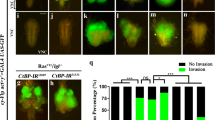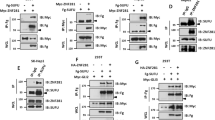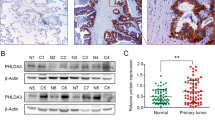Abstract
Wingless and int homologue (Wnt) family proteins have been shown to have important roles in the decision of cell fate and behavior at multiple stages during the development and tumorigenesis. One of the Drosophila segment polarity genes, porcupine (porc) gene, encodes an evolutionarily conserved endoplasmic reticulum membrane protein involving in the post-translational processing of the Wnt family proteins. Here, we report that human homologue of Drosophila porc gene, PPN/MG61, was abundantly expressed in human cancer cell lines, but not in normal cells. We also found that PPN/MG61 was overexpressed in primary lung cancer tissue samples, compared to their matched normal tissue samples. Furthermore, when we used small interfering RNA to knock down PPN/MG61 mRNA in lung cancer cells expressing the gene, we observed apoptosis induction, along with decreased activity of Wnt pathway in those lung cancer cells. These data suggest that PPN/MG61 may be a novel marker for human lung cancer and that post-translational modification of the Wnt signal molecules by PPN/MG61 may be important for the function of Wnt pathway in lung cancer.
This is a preview of subscription content, access via your institution
Access options
Subscribe to this journal
Receive 50 print issues and online access
$259.00 per year
only $5.18 per issue
Buy this article
- Purchase on Springer Link
- Instant access to full article PDF
Prices may be subject to local taxes which are calculated during checkout




Similar content being viewed by others
References
Akiyama T . (2000). Wnt/beta-catenin signaling. Cytokine Growth Factor Rev 11: 273–282.
Caricasole A, Ferraro T, Rimland JM, Terstappen GC . (2002). Molecular cloning and initial characterization of the MG61/PORC gene, the human homologue of the Drosophila segment polarity gene Porcupine. Gene 288: 147–157.
He B, Reguart N, You L, Mazieres J, Xu Z, Lee AY et al. (2005). Blockade of Wnt-1 signaling induces apoptosis in human colorectal cancer cells containing downstream mutations. Oncogene 24: 3054–3058.
He B, You L, Uematsu K, Xu Z, Lee AY, Matsangou M et al. (2004). A monoclonal antibody against Wnt-1 induces apoptosis in human cancer cells. Neoplasia 6: 7–14.
Hofmann K . (2000). A superfamily of membrane-bound O-acyltransferases with implications for wnt signaling. Trends Biochem Sci 25: 111–112.
Kadowaki T, Wilder E, Klingensmith J, Zachary K, Perrimon N . (1996). The segment polarity gene porcupine encodes a putative multitransmembrane protein involved in Wingless processing. Genes Dev 10: 3116–3128.
Katoh M . (2005). WNT/PCP signaling pathway and human cancer (review). Oncol Rep 14: 1583–1588.
Mazieres J, You L, He B, Xu Z, Lee AY, Mikami I et al. (2005a). Inhibition of Wnt16 in human acute lymphoblastoid leukemia cells containing the t(1;19) translocation induces apoptosis. Oncogene 24: 5396–5400.
Mazieres J, You L, He B, Xu Z, Twogood S, Lee AY et al. (2005b). Wnt2 as a new therapeutic target in malignant pleural mesothelioma. Int J Cancer 117: 326–332.
Mikami I, You L, He B, Xu Z, Batra S, Lee AY et al. (2005). Efficacy of Wnt-1 monoclonal antibody in sarcoma cells. BMC Cancer 5: 53.
Mikels AJ, Nusse R . (2006). Wnts as ligands: processing, secretion and reception. Oncogene 25: 7461–7468.
Miller JR . (2002). The Wnts. Genome Biol 3: REVIEWS3001.
Moon RT, Kohn AD, De Ferrari GV, Kaykas A . (2004). WNT and beta-catenin signalling: diseases and therapies. Nat Rev Genet 5: 691–701.
Reya T, Clevers H . (2005). Wnt signalling in stem cells and cancer. Nature 434: 843–850.
Rhee CS, Sen M, Lu D, Wu C, Leoni L, Rubin J et al. (2002). Wnt and frizzled receptors as potential targets for immunotherapy in head and neck squamous cell carcinomas. Oncogene 21: 6598–6605.
Tanaka K, Kitagawa Y, Kadowaki T . (2002). Drosophila segment polarity gene product porcupine stimulates the posttranslational N-glycosylation of wingless in the endoplasmic reticulum. J Biol Chem 277: 12816–12823.
Tanaka K, Okabayashi K, Asashima M, Perrimon N, Kadowaki T . (2000). The evolutionarily conserved porcupine gene family is involved in the processing of the Wnt family. Eur J Biochem 267: 4300–4311.
Thorpe CJ, Schlesinger A, Carter JC, Bowerman B . (1997). Wnt signaling polarizes an early C. elegans blastomere to distinguish endoderm from mesoderm. Cell 90: 695–705.
Veeman MT, Axelrod JD, Moon RT . (2003). A second canon. Functions and mechanisms of beta-catenin-independent Wnt signaling. Dev Cell 5: 367–377.
Weeraratna AT, Jiang Y, Hostetter G, Rosenblatt K, Duray P, Bittner M et al. (2002). Wnt5a signaling directly affects cell motility and invasion of metastatic melanoma. Cancer Cell 1: 279–288.
Widelitz R . (2005). Wnt signaling through canonical and non-canonical pathways: recent progress. Growth Factors 23: 111–116.
Willert K, Brown JD, Danenberg E, Duncan AW, Weissman IL, Reya T et al. (2003). Wnt proteins are lipid-modified and can act as stem cell growth factors. Nature 423: 448–452.
Winn RA, Marek L, Han SY, Rodriguez K, Rodriguez N, Hammond M et al. (2005). Restoration of Wnt-7a expression reverses non-small cell lung cancer cellular transformation through frizzled-9-mediated growth inhibition and promotion of cell differentiation. J Biol Chem 280: 19625–19634.
You L, He B, Uematsu K, Xu Z, Mazieres J, Lee A et al. (2004). Inhibition of Wnt-1 signaling induces apoptosis in beta-catenin-deficient mesothelioma cells. Cancer Res 64: 3474–3478.
You L, He B, Xu Z, Uematsu K, Mazieres J, Fujii N et al. (2004). An anti-Wnt-2 monoclonal antibody induces apoptosis in malignant melanoma cells and inhibits tumor growth. Cancer Res 64: 5385–5389.
Zhai L, Chaturvedi D, Cumberledge S . (2004). Drosophila wnt-1 undergoes a hydrophobic modification and is targeted to lipid rafts, a process that requires porcupine. J Biol Chem 279: 33220–33227.
Acknowledgements
This work was partially supported by funds from National Key Basic Research Project (No 2007CB914401), the National Key Basic Research and Development (973) Program of China (No 06CB503905), the China Natural Science Foundation (No 30770475), the Science and Technology Program of Zhejiang Province (No 2007C24021) and a research fund from Beijing ACCB Biotech Ltd. We thank Dr. Jingyi Gong and Dr. Yang Liu in Tsinghua University for their instructions for using fluorescence microscopy.
Author information
Authors and Affiliations
Corresponding author
Rights and permissions
About this article
Cite this article
Chen, Z., Li, J., Li, Q. et al. Suppression of PPN/MG61 attenuates Wnt/β-catenin signaling pathway and induces apoptosis in human lung cancer. Oncogene 27, 3483–3488 (2008). https://doi.org/10.1038/sj.onc.1211006
Received:
Revised:
Accepted:
Published:
Issue Date:
DOI: https://doi.org/10.1038/sj.onc.1211006
Keywords
This article is cited by
-
TGIF1 promoted the growth and migration of cancer cells in nonsmall cell lung cancer
Tumor Biology (2015)



